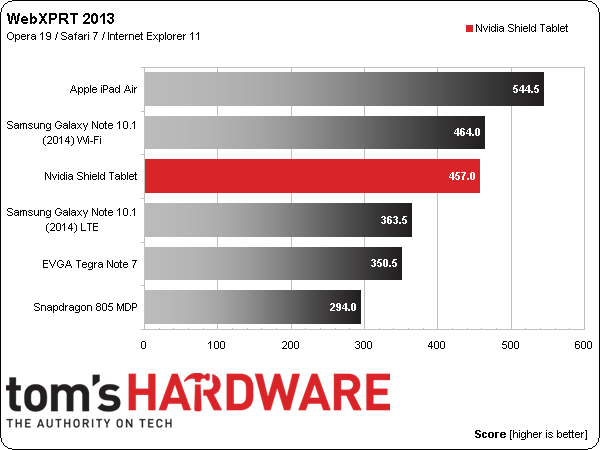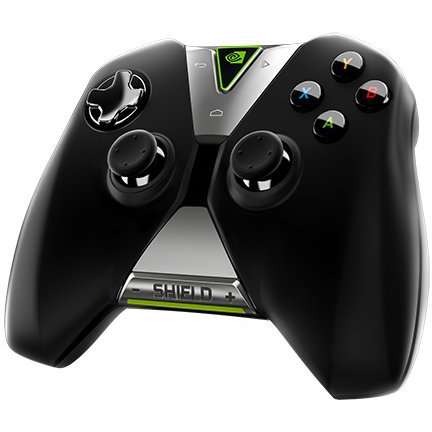Nvidia Shield Tablet And Shield Controller Review
The Shield Tablet, powered by Nvidia’s Tegra K1 SoC, deftly handles browsing and media playback duties. Combining it with the wireless Shield Controller transforms the 8-inch device into an exciting mobile gaming platform.
Results: HTML5 And JavaScript Benchmarks
The tests on this page are JavaScript- and HTML5-heavy selections from our Web Browser Grand Prix series. Such tests are extremely meaningful to mobile devices because so much of the in-app content is served via the platform's native Web browser. These tests not only offer a view of each device's Web browsing performance, but since these tasks are traditionally so CPU-dependent, browser benchmarks (especially JavaScript-heavy tests) are a great way to measure SoC performance among devices using the same platform and browser.
JSBench
Unlike most JavaScript performance benchmarks, JSBench could almost be considered real-world, since it utilizes actual snippets of JavaScript from Amazon, Google, Facebook, Twitter and Yahoo.
JSBench doesn’t take advantage of more than two cores and seems insensitive to CPU clock rate, its performance primarily dependent on CPU architecture. Apple’s A7 posts the best time followed by the three SoCs with -A15 cores. Krait doesn’t handle this benchmark well, posting the two worst times.
The one anomaly is Tegra K1, completing the benchmark 20% faster than both the Tegra 4 and Exynos 5 Octa. It’s tempting to ascribe this result to K1’s frequency advantage, which is about the same percent difference. However, none of the other SoCs sharing the same CPU architecture see any benefit from frequency scaling or additional memory bandwidth. All three SoCs also use the same 2MB L2 cache. Tegra K1 does use the newer revision -A15 cores (r3p3), but looking through the ARM revision history only reveals “engineering errata fixes” and some additional clock gating features introduced in r3p0. There's nothing that would explain a 20% performance improvement.
Peacekeeper 2.0
Peacekeeper is a synthetic JavaScript performance benchmark from Futuremark.
We see nearly the exact same trend in Peacekeeper. The iPad Air holds a 24% advantage over the Shield Tablet, which is 23% faster than the other two SoCs with -A15 cores.
WebXPRT 2013
Principled Technologies' WebXPRT 2013 is an HTML5-based benchmark that simulates common productivity tasks traditionally handled by locally-installed applications, including photo editing, financial charting and offline note-taking.
Get Tom's Hardware's best news and in-depth reviews, straight to your inbox.
Tegra K1 isn’t able to break the A7s dominance in our browser benchmarks, only achieving 81% of its high score. The Exynos 5 Octa matches Tegra K1s performance, but Tegra 4 trails behind. Curiously, Qualcomm’s highest-clocked Snapdragon, the 805, comes in last, trailing the lower-clocked Snapdragon 800 in the Samsung Galaxy Note 10.1 LTE.
Current page: Results: HTML5 And JavaScript Benchmarks
Prev Page Results: CPU Core Benchmarks Next Page Results: GPU Core Benchmarks-
blubbey Those GPGPU benchmarks are ridiculous in comparison. It looks like a great bit of kit from what I've seen so far. A die shrunk Maxwell should be fantastic. Maybe even a lower clocked version just for power consumption? It'll still perform as well, if not better than the K1 at 750MHz (assuming 2 SMMs) I'd assume.Reply -
Memnarchon "Based on these results, Tegra K1 must be “a neural net processor; a learning computer” sent back through time to destroy all of the other SoCs that could lead a rebellion in the post-apocalyptic future."Reply
Lol this is epic! xD
Anyway, great and unique review. Especially for the so many GPGPU benchmarks.
Nvidia tablet at $299 seems to be a great buy. -
aberkae If maxwell brings double the performance per watt on the same node the next tegra chip on 20 nm node should be a home run for the companyReply -
deftonian Impressive, but I feel it's still missing that "umph" to get me to buy this and carry it around as an added device, next to my phone (Note 3). Maybe I just don't game enough on the android market or steam. Either way, I think it is impressive for a mobile gaming device and all the things it offers. I think they've started a great line and hope it grows into a successful tablet/gaming brand.Reply -
aberkae If maxwell brings double the performance per watt on the same node the next tegra chip on 20 nm node should be a home run for the companyReply -
gio2vanni86 The streaming a game while i'm at my friends house using my PC at home is what has me very interested. Plug into his TV and play amazing games he can only dream of. I'm in.Reply -
vithrell Just wait for Intel's Core M. It wont match the price (CPU alone will cost $300), but in fanless tablet form factor it wont have worthy competitor. Early GPU benchmarks give Core M 55k graphics score in Ice Storm, so more than 1.5x more power than Tegra K1. AND you can run full Windows on it. I wish Nvidia took x86 path with its cpu cores.Reply





